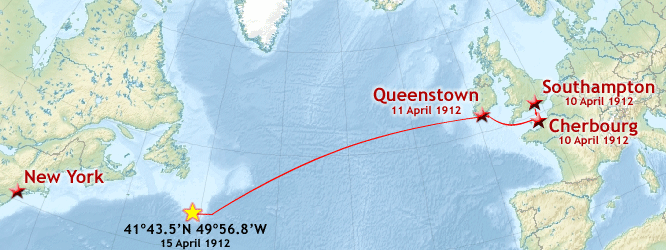On April 10, 1912 over 2200 passengers boarded the Titanic on its maiden voyage to New York. Many of them were immigrants who saved all their money for the journey. First class passengers had to pay between $2 500 and $4 500 for a private room and a bath, third class passengers had to share rooms and paid $35 each.
Although the ship’s owners said the Titanic was unsinkable many problems before the first voyage were overlooked. Safety regulations at that time were not very strict. The ship only had 16 life boats, enough for about 1 500 passengers. It was only tested for a few hours and never went at full speed. The telegraph system on board was new and not many people knew how to operate it.

The Titanic leaving Southampton on April 10, 1912
Image: Francis Godolphin Osbourne Stuart, Public domain, via Wikimedia Commons
During the night of April 14, 1912 the waters of the North Atlantic had a temperature of about -2° C. At noon on that day the radio operators got messages from other ships about icebergs that were nearby. The Titanic’s captain, Edward Smith, did not care about these warnings. He was captain of a steel giant that could not sink. The only thing he cared about was setting up a new world speed record. The Titanic was to be the fastest ship that ever sailed from Southampton to New York.
The night was clear and the Titanic sped on. When a big iceberg was sighted the first officer shut down all the engines. But it would have taken the ship about half a mile to come to a full stop. Even though, on the surface, the ship stayed clear of the iceberg, it ripped a big hole in the hull. At once the compartments began to flood with cold, icy water. The bulkheads were lowered but it was too late. Water flooded at least five compartments.
The collision with the iceberg was so slight that the passengers hardly heard it. Most of them didn’t take any notice and continued dancing and having fun. Some passengers were asleep in their cabins.
The bow of the ship dipped under the water’s surface and the back part of the ship began to rise. After a short time the Titanic broke into two pieces. When Captain Smith realized that the Titanic was sinking he had a distress signal sent out but the nearest ship was a hundred kilometres away.
As time went on chaos emerged and passengers rushed to the boat deck. Women and children were allowed on the lifeboats first. Lights flickered and electricity was finally gone. At 2:20 a.m. the Titanic disappeared into the Atlantic Ocean.
The Carpathia, which was the nearest ship, came to the scene about two hours later and picked up the freezing passengers in their lifeboats. By early morning the news of the disaster had gone around the world. The world’s largest ocean liner, the Titanic, had sunk on its maiden voyage, killing 1513 people.

The Titanic’s maiden voyage across the North Atlantic
Image: Prioryman, CC BY-SA 4.0, via Wikimedia Commons